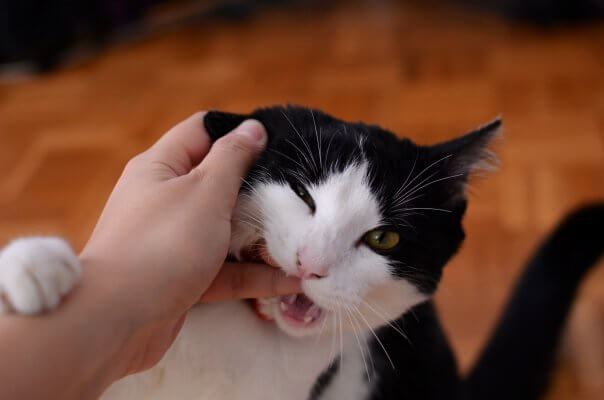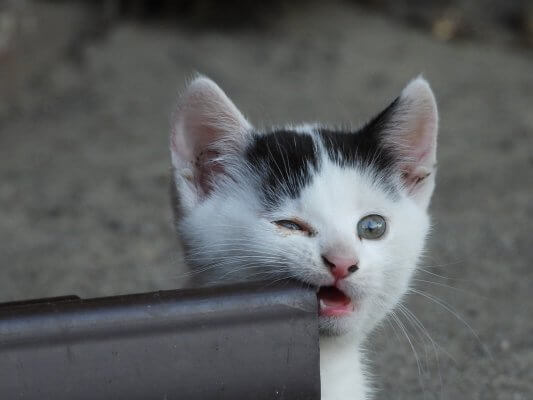Cats are often seen as independent and aloof pets but can also exhibit behaviors like biting that may seem confusing or aggressive to owners. By understanding some of the most common reasons behind cats biting, cat parents can get to the root of the behavior and take steps to curb it.
Territorial Behavior
One of the most prevalent reasons for cat bites is territorial behavior. Cats are instinctively protective of their domain and possessions. A cat may bite to defend its territory, such as a favorite spot on the couch or a preferred toy. Biting is the cat’s way of conveying, “Back off, this is mine.”
Territorial aggression often occurs between cats in multi-cat households. One cat may bite another that gets too close to its claimed territory. Cats may also bite family members in a territorial display. For example, if a person disturbs a cat while sleeping in its preferred spot, it may react with a warning nip.
Managing Territorial Biting
- Provide multiple resources like food bowls, beds, and litter boxes so cats have less reason to compete.
- Give each cat their own defined territory in the home.
- Use calming pheromone diffusers to ease tension between territorial cats.
- Discourage biting behavior with a firm “no” and redirect the cat’s energy with play.
Fear or Anxiety
Cats are hardwired for survival, and fear is another common trigger for biting. A scared, anxious, or frightened cat may bite as a self-defense mechanism. Cats often bite during veterinary exams, grooming, or other situations when they feel threatened and want to escape.
Some cats are more easily alarmed than others due to their genetics or lack of socialization. Quick movements, loud noises, unfamiliar people, and other stimuli can all elicit a bite from a fearful cat. Pain or illness can also cause anxiety that leads to biting.
Reducing Fear-Based Biting
- Use positive reinforcement and treats to teach cats that new people, experiences, and handling are not threats.
- Avoid punishment, which will only increase anxiety and biting behavior.
- Address potential sources of fear or pain that are triggering bites.
- Provide secure hiding spots and cat towers to help timid cats feel safe.
- Try calming aids like Feliway or CBD treats to reduce anxiety.
Overstimulation
Cats have subtly defined boundaries; too much petting, handling, or stimulation can cross the line and provoke bites. Pet owners often misinterpret bites due to overstimulation as unpredictable or aggressive reactions.

But cats communicate through body language, and prior to biting, they usually give signals like swishing tail, folded back ears, skin rippling, or turning their head that they’ve had enough handling. Continuing to stimulate the cat overrides these warnings and leads to defensive biting.
Preventing Overstimulation Biting
- Learn to read and respond to cats’ body language signals.
- Keep petting and play sessions brief to avoid overstimulating cats.
- Schedule regular nail trims to keep them short and avoid bites during grooming.
- Provide appropriate outlets for play, like wands, puzzle toys and scratching posts.
- Trim overgrown fur mats carefully not to pull skin and provoke bites.
Prey Drive
While domesticated, cats still have powerful prey drive instincts to stalk, chase, capture, and kill prey. They may bite their owners in a heightened state of prey arousal, especially during play with wiggling fingers, feet under blankets or other tempting stimuli that trigger their hunting response.
While owners may endure gentle nibbles during playtime, too much bite pressure becomes painful. Biting during prey drive is not typically aggressive, but stems from uncontrolled natural impulses.
Curtailing Prey-Based Biting
- Use fishing pole toys and laser pointers to satisfy cats’ prey drive at a distance from human hands and feet.
- Avoid rough play with hands and feet so cats don’t associate them with prey.
- Direct the cat’s energy with appropriate toys when they get overstimulated.
- Discourage biting and end play sessions if the cat bites down too hard.
Biting for Attention
Some cats learn that biting gets them attention, even if it’s negative attention. Here’s how to curb attention-seeking bites:
Solution
- Ignore the biting completely. Don’t even look at your cat when they bite for attention.
- Walk away and isolate them for 5-15 minutes after biting to signal that the behavior is not acceptable.
- Reward them with treats and attention when they play gently and do not bite. Positive reinforcement can encourage desired behavior
Oral or Dental Pain
Similarly to humans, oral pain due to conditions like gum disease, abscesses, fractured teeth, or other mouth ailments can make cats more prone to biting. The mouth is a vulnerable area of the body, so cats bite both offensively and defensively to protect painful areas.

Cats experiencing oral discomfort may exhibit signs like reduced eating, drooling or bad breath. Biting seemingly without warning could be a sign it’s time for a vet dental exam. Treating underlying dental issues typically resolves pain-induced biting.
Preventing Dental Biting
- Provide dental treats, crunchy food and chew toys to keep cats’ teeth clean.
- Schedule regular veterinary dental cleanings and oral exams.
- Watch for subtle signs of mouth pain, like shying away from brushing.
- Address oral health issues immediately to improve comfort and curb biting.
- Apply antibiotic gel to fractured teeth to alleviate pain until they can be extracted.
Why Cats Lick Then Bite me?
It’s not uncommon for cats to gently lick their owners as a sign of affection, only to suddenly turn and deliver a nip or bite. This behavior stems from overstimulation. The licking builds up excessive sensory input for the cat, who then reacts with a bite to say “enough!”
Cats have subtle boundaries when it comes to touch and stimulation. Licking heightens arousal, crossing the line to irritation. Owners can avoid lick-then-bite situations by keeping petting brief and watching for signals like twitching tail or ears folded back that indicate overstimulation. Redirecting the cat’s energy to toys or treats can also prevent an impending nip after licking.
The Takeaway
Cat bites can be alarming, but are most often a form of communication, not random aggression. By understanding common causes like territorial disputes, fear, overstimulation and oral pain, cat parents can get to the root of the behavior and utilize tactics like more resources, behavioral training, environmental changes and healthcare to curb biting. Learning cat body language and respecting their boundaries prevents many bites. With time and patience, cat owners can identify why their cat lashes out with bites and create a harmonious relationship built on trust.

Share this helpful guide for decoding cat bites now so other cat lovers can gain insight into this common feline behavior. The more we understand the natural motivations behind cats’ actions, the better we can provide happy, healthy homes for our fascinating feline friends.


